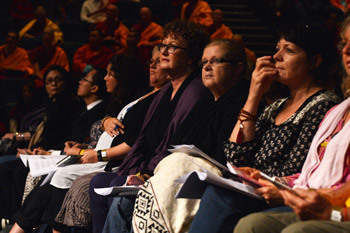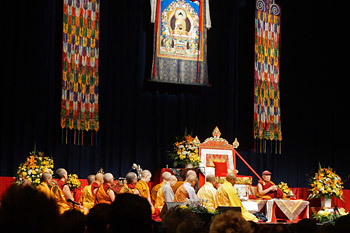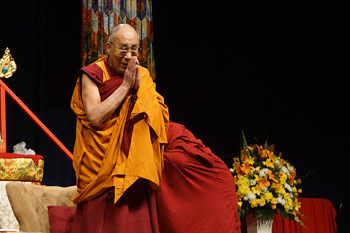Uluru, Northern Territory, Australia, 12 June 2015 - His Holiness the Dalai Lama reached the Brisbane Convention and Exhibition Centre early this morning. Not all the audience had arrived, so he suggested they start the session by asking questions. To begin with a woman wanted to confirm what she had understood from the previous day’s explanations of emptiness. She said she understood she was really formless, eternal and not conscious. His Holiness told her that it was important not to overlook empirical experience that things do exist on a conventional level. It’s not a matter of whether things exist, they do, but of how they exist, which is not the way they appear. To say things are empty is not to deny that they exist at all.
He also reiterated that it’s on the basis of a misconception about how things exist that we generate destructive emotions such as anger and attachment towards them. Establishing how things really exist undermines the basis of these destructive emotions. When she retorted that even after things’ independent existence has been negated, there still remains some indefinable essence, His Holiness replied that if things possessed some unchanging essence they couldn’t be dependent. He made the serious suggestion that since she was still young and had the time to study, she look into what is explained in Quantum Physics.
Someone asked about the bodhisattva’s giving his flesh to the hungry tigress and His Holiness confirmed that if a good purpose can be served, giving away parts of the body is condoned. He told another person, who wanted to know about the very first Buddha and how he attained enlightenment, that to think of a primordial Buddha in that way was a mistake.
Telling His Holiness how many people support freedom in Tibet, another woman wanted to know how they could contribute to it. He replied:
“Firstly, I was 16 when I took responsibility for Tibet. In 1954/55 I went to Peking and met Mao Zedong with whom I formed a good relationship. At that time, as revolutionary, he seemed both practical and realistic. When he suggested the forming of a preparatory committee for the autonomous region of Tibet, we agreed to it. In 1956, in parts of eastern Tibet that were beyond the Tibetan government’s jurisdiction, over eager officials implemented unsuitable reforms and an uprising began. Around that time I came to India to attend celebrations of the Buddha’s 2500th anniversary. I held discussions with Pandit Nehru and Zhou Enlai, who was travelling with He Long. Zhou assured me reforms could be delayed six years or more, but in 1957 the 100 Flowers Campaign put paid to that.

|
Members of the audience listening to His Holiness the Dalai Lama speaking during the final session of his teaching in Brisbane, Queensland, Australia on June 12, 2015.
Photo/Rusty Stewart
|
“By 1959 there was no choice but to escape. Having made an appeal to the UN in 1950, we appealed three more times to little effect. Nehru told me that the USA would not go to war with China over Tibet. In the late ‘60s and early ‘70s we concluded that we would have to approach China, not seeking independence but dialogue. However, hardliners were still intent on attacking the Tibetan identity, language and spiritual traditions.
“Today, people in China, where there are 400 million Buddhists, Japan, Korea and Vietnam are taking an interest in Tibetan Buddhism. Therefore, preserving our traditions is not only of concern to Tibetans. What’s more Xi Jinping has publicly acknowledged the importance of Buddhism to Chinese culture.
“Since 2011 I have completely retired from political responsibilities and have put an end to the Dalai Lamas’ involvement in such affairs in future. So, I’m sorry to have given you this somewhat political reply, but I thought it might be useful. I would like to tell you how much I appreciate your support. Thank you.”
His Holiness then resumed his reading of the ‘Precious Garland’ with the following verses that introduce the idea of generating the awakening mind of bodhichitta.
174
If you and the world wish to attain
Unparalleled enlightenment,
Its roots are the altruistic aspiration to enlightenment
Firm like the monarch of mountains,
Compassion reaching to all quarters,
And wisdom not relying on duality.

|
A view of the stage of the Brisbane Convention and Exhibition Centre during the final session of His Holiness the Dalai Lama's teaching in Brisbane, Queensland, Australia on June 12, 2015. Photo/Jeremy Russell/OHHDL
|
He explained that once you are motivated by the awakening mind whatever you do to help others, you will generate great merit. The text states that the form body of a Buddha arises from collections of merit, while the truth body arises from collections of wisdom. In addition, the limitless collections of merit and wisdom quickly eradicate physical and mental suffering.
He clarified that when it comes to ways to generate the awakening mind there are two methods, the Seven Cause and One Result approach and the method of Equalizing and Exchanging Self for Others. The second is the more powerful and is the one described here and in Shantideva’s ‘Guide to the Bodhisattva’s Way of Life’. His Holiness spoke about how, to begin with, applying these methods requires effort. You can meditate on them, but when you come out of meditation you have to make an effort to apply them again in day to day life. However, the aim is to continue the practice until such an aspiration arises effortlessly. He indicated the first of 20 verses to recite to enhance the awakening mind every day, which conclude as follows:
May I always be an object of enjoyment
For all sentient beings according to their wish
And without interference, as are the earth,
Water, fire, wind, herbs, and wild forests.
May sentient beings be as dear to me as my own life,
And may they be dearer to me than myself.
May their ill deeds bear fruit for me,
And all my virtues bear fruit for them.
As long as any sentient being
Anywhere has not been liberated,
May I remain for the sake of that being
Though I have attained highest enlightenment.
|
Swimmer Ian Thorpe introducing His Holiness the Dalai Lama to a capacity audience of over 4,000 at the start of his talk in Brisbane, Queensland, Australia on June 12, 2015.
Photo/Rusty Stewart
|
Returning to the same hall after lunch, His Holiness shared the stage with comedian Meshel Laurie and swimmer Ian Thorpe who introduced him to a capacity audience of 4000. His Holiness lost no time in beginning his talk.
“Brothers and sisters - I always say this because we are truly human brothers and sisters. When children are young, they don’t care what religion, race or country people come from or whether they are rich or poor, but we lose this openness when we grow up.
“Many of the problems we face today are our own creation. I’ve just had a good lunch and right now we’re enjoying being together in this big hall, but elsewhere in the world there are refugees, on the borders of Burma, Bangladesh and in North Africa, for example, without shelter or food. Life is precious and it’s really sad when it’s lost. It’s unthinkable that people are killing each other in the name of religion, when the message of all major religions is love.
“This all revolves round emphasising the differences between us. And yet at the same time climate change and the global economy mean we need instead to focus on the oneness of the human family. We need to remember that others are just like us. They also have a right to live a happy life. If people thought of each other more as brothers and sisters, they wouldn’t be so ready to kill each other.
“If we were to promote a greater sense of the oneness of humanity starting now, it might not make an immediate difference. But after one or two decades, if the next generation were better educated in this way, they might make the world a better place.”
|
His Holiness the Dalai Lama speaking during his talk in Brisbane, Queensland, Australia on June 12, 2015. Photo/Rusty Stewart
|
His Holiness spoke about how fear can be both the cause and the result of a loss of trust. He said that when people are more warm-hearted they inspire greater trust in others and that trust becomes the basis for friendship. From so many different angles, warm-heartedness is the real basis for happiness. He mentioned too how important affection is in our lives.
Observing that most education systems today are oriented towards materialistic goals and that most of us live in a materialistic culture, he stated that we lack a proper understanding of the workings of the mind. He suggested resolving these shortcomings by introducing a map of the emotions and a sense of secular ethics. He clarified that he uses the word secular in the way it is used in multi-religious India, indicating unbiased respect for all religions and even the views of non-believers.
His Holiness sat down between Meshel Laurie and Ian Thorpe who put questions from the public to him that ranged from the role of his mother in his childhood - she spoiled him - to where he considers home. He quoted a Tibetan saying that the place where you feel happy is home.
Among his answers to being asked whether the world’s best days are behind us he mentioned that people are more reluctant now to go to war than they were in the 20th century. Likewise, when Gandhi employed non-violence, people thought it a sign of weakness. Nevertheless, Nelson Mandela and Martin Luther King eventually used it to good effect. Challenged to explain what goes on in reincarnation he replied that obviously the body doesn’t go on, but the more subtle mind can do so because it is a continuity.
|
The Brisbane Convention and Exhibition Centre, venue for His Holiness the Dalai Lama's teaching and talk in Brisbane, Queensland, Australia on June 12, 2015. Photo/Rusty Stewart
|
Coming to the end of the allotted time, His Holiness explained that he was leaving to travel to Uluru, a place regarded by many as the spiritual heart of Australia. But before he left the stage, he made a request to the audience:
“When you wake up in the morning take a moment to think about how the whole of humanity are your brothers and sisters.”
Making a brisk departure he drove to Brisbane airport and boarded a plane that flew across the eastern half of the country to arrive at Uluru. He landed as the sun was going down, casting long shadows across the open country. He was welcomed by a mixed crowd of well-wishers, many Tibetans among them who have come just for this occasion.



